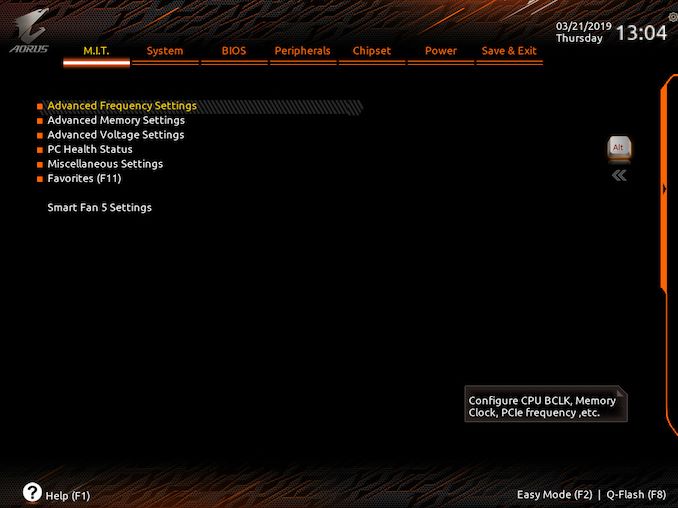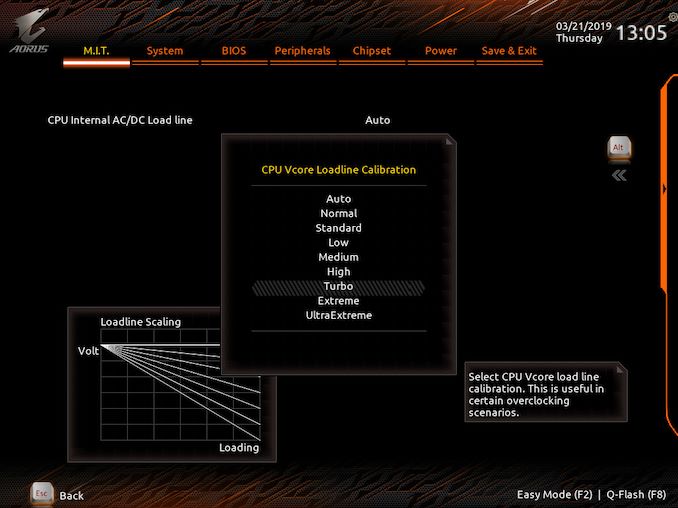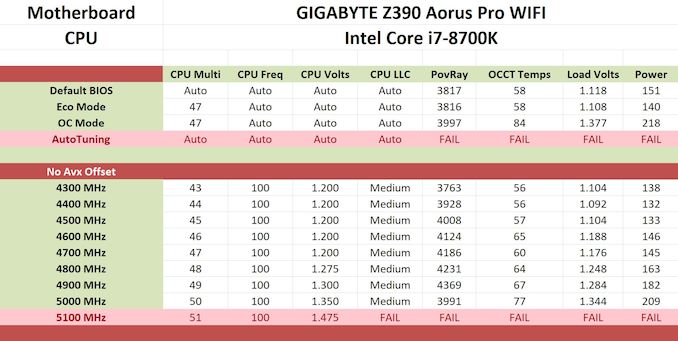The GIGABYTE Z390 Aorus Pro WIFI Motherboard Review: A Sturdy $200 Surprise
by Gavin Bonshor on April 12, 2019 10:00 AM ESTOverclocking
Experience with the GIGABYTE Z390 Aorus Pro WIFI
The GIGABYTE Z390 Aorus Pro WIFI uses 'strong and stable' firmware with a good set of customizable options for overclocking. As we found in our previous GIGABYTE Z390 Aorus Master review, overclocking using GIGABYTE's Z390 models come with their own experience and with the right settings adjusted, can overclock perfectly fine.
Each of the three main variables when it comes to overclocking (CPU, memory and voltage) each have their own menus and splitting them up allows users to not only focus overclocking on one component at a time but keeps things simple and clutter-free. Our testbed Intel Core i7-8700K processor on even the most comprehensive of motherboards has a limitation of 5.1 GHz at around 1.45 V. Above 1.35 V on the CPU VCore, we generally experience thermal throttling which is still stable, but this does have a negative impact on performance. This comes down to the board's default fan profiles as some models ramp the fans up to the maximum which does improve performance, but some do not. This creates a trade-off between computational performance, thermal performance and also acoustic performance.
With the intention of overclocking our Intel Core i7-8700K processor, the power delivery uses an Intersil ISL69138 seven channel PWM controller in a 6+1 configuration. While the in the previous GIGABYTE review we found that the voltage sensors were inaccurate, we didn't experience this issue with the Z390 Aorus Pro WIFI which made things easier. There was a slight variance between the VR VOUT sensor on the ISL69138 and what CPU-Z was reporting, it wasn't big enough to cause concern.
Overclocking Methodology
Our standard overclocking methodology is as follows. We select the automatic overclock options and test for stability with POV-Ray and OCCT to simulate high-end workloads. These stability tests aim to catch any immediate causes for memory or CPU errors.
For manual overclocks, based on the information gathered from the previous testing, starts off at a nominal voltage and CPU multiplier, and the multiplier is increased until the stability tests are failed. The CPU voltage is increased gradually until the stability tests are passed, and the process repeated until the motherboard reduces the multiplier automatically (due to safety protocol) or the CPU temperature reaches a stupidly high level (90ºC+). Our test bed is not in a case, which should push overclocks higher with fresher (cooler) air.
Overclocking Results
For the purpose of overclocking our i7-8700K on the Z390 Aorus Master, we changed the following settings which generally on other boards we've tested, have been left completely untouched. It's not unusual to disable the C-states and alter power settings when overclocking.
- CPU VCore Loadline Calibration - Medium
- All C-States - Disabled
- EIST (Intel SpeedStep Technology) - Disabled
- Intel Speed Shift - Disabled
The GIGABYTE Z390 Aorus Pro WIFI and the Easy Tune software opens up three different overclocking profiles; Eco, OC Mode and Auto Tuning. When using the Auto Tuning setting, we experienced hangs and crashes before the firmware would even initialize its cycle which means either there is an issue with the board, or the Auto Tuning overclock isn't supported on the Z390 Aorus Pro WIFI. The Eco mode applies a 4.7 GHz overclock on a single core (from six) on our i7-8700K with 1.108 V on the CPU VCore, while the OC Mode applies a 4.7 overclock across all six cores with 1.377 V on the VCore; this was too much voltage for our chip as we did hit thermal throttling which was a detriment to performance.
Manually overclocking our i7-8700K testbed processor from 4.3 GHz to 5.0 GHz was an easy task and although we had to apply the medium profile to the CPU VCore Loadline Calibration at some frequencies to get it stable, we re-tested at all the frequencies with this applied for consistency purposes. This highlights a slight issue of stability at higher frequencies such as 4.8 GHz and above with settings applied that would otherwise be fine on other boards. While adjusting the power settings, disabling C-States and applying a mid-level LLC profile did allow us to achieve 5.0 GHz stable with 1.35 V on the CPU VCore, the overall performance of this board is average, albeit competitive for the price point it's situated at. We also required more voltage for 4.9 GHz with 1.30 V on the CPU VCore which would usually net us an overclock of 5.0 GHz on better, and more premium models. Unfortunately, it is clear that the 5.0 GHz overclock was throttling during POV-Ray, so our recommendation on this chip would be 4.9 GHz.













33 Comments
View All Comments
Alistair - Friday, April 12, 2019 - link
The problem I've had with several Z390 boards is their inability to handle the 9900k at full load above 4.5ghz. Prime95 will reduce the clock speed to about 4.5ghz despite settings. It's not just a VRM temp issue causing the downclock. You're better off with an 8700k than a 9900k imo with this board. I wish the 9900k OC was tested with prime95 in the review :)dotes12 - Friday, April 12, 2019 - link
Any version of Prime95 after 26.6 use AVX instead of SSE instructions. Most people overclock their CPU to be stable at the workloads they typically perform, and 100% AVX is not a typical workload for most people. To help people overclock, the Z390 chipset allows the detection of AVX workloads and allow an overclock deduction (AVX Offset) to continue to be stable and not create so much heat. I tried disabling my AVX offset and it would always crash my 9900K running at 5.0 GHz within a couple seconds of starting the Prime95 AVX test.Surfacround - Friday, April 12, 2019 - link
interesting, asus my z390i-gaming and i9-9900k (with evga 750p2 psu and nzxt h41 AIO cooler) can pull 250w running prime95 or y-cruncher...(hwinfo watt readout) (serious heat... 95-100c) but it does not crash...weevilone - Monday, April 15, 2019 - link
So the solution to rigorous AVX workloads on the 9900K is to go with a CPU that uses fewer cores to make your overclock look better? Ok..LoneWolf15 - Sunday, June 2, 2019 - link
Did you turn off AVX tests to run Prime95? AVX testing was added in recent versions, and really raises the temps. Testing for stability, most recommend turning AVX off.I haven't done Prime95, but I'm rock-stable 24/7 for days/weeks of Folding@home running all eight CPU cores of my 9900K to 100% at 4.8GHz using this board.
drexnx - Friday, April 12, 2019 - link
I can never tell if the lower part of the aorus logo is the lower jaw of the bird, or if it's a bird-man hybrid and it's doing a bicep curl.Cellar Door - Friday, April 12, 2019 - link
Neither - its the talon(claw). Just imagine an eagle/falcon swooping down to attack its prey.On a side note - Gigabyte doesn't cheap out on features (wifi, 1220 audio and solid vrm) but I do agree a wonky bios can ruin a positive user experience.
After reading about poor OC bios section - on their b450 and x470 Ryzen boards, in the end I went with Asus, even though I had to pay after %15.
Death666Angel - Friday, April 12, 2019 - link
Seems weird that the talon is pointed the wrong way up? :)I've had pleasureable experiences with Gigabyte during the P55 era and have a nice little parallel port Atom ITX board. I'm currently running an MSI mainboard and have had great AsRock ones.
MDD1963 - Saturday, April 13, 2019 - link
So the talon hand is doing a biceps curl/posing routine? :)29a - Friday, April 12, 2019 - link
birdman for sure